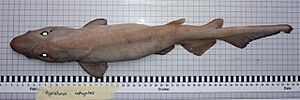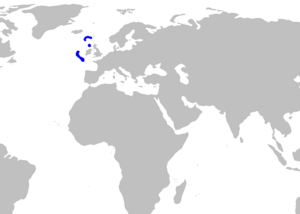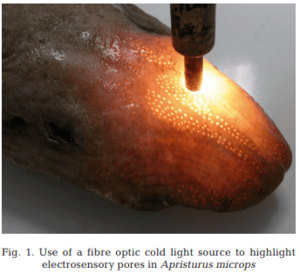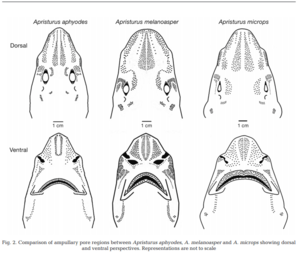White ghost catshark facts for kids
Quick facts for kids White ghost catshark |
|
|---|---|
 |
|
| Conservation status | |
| Scientific classification | |
| Genus: |
Apristurus
|
| Species: |
aphyodes
|
 |
|
| Distribution (in blue; click to enlarge) | |
The white ghost catshark (Apristurus aphyodes) is a type of shark that lives deep in the ocean. It belongs to the catshark family, called Scyliorhinidae. You can find this shark in the northeast Atlantic Ocean, in very cold, dark waters. It lives between 57°N and 58°N latitude.
This deep-sea catshark has only been seen a few times. Scientists have found it in the eastern North Atlantic at depths from 1,014 to 1,800 meters (about 3,327 to 5,906 feet). The white ghost catshark can grow up to 54 centimeters (about 1.7 feet) long. This is a medium size for sharks in the Apristurus group.
Contents
What Does the White Ghost Catshark Look Like?
The white ghost catshark has a thin, tube-shaped body. Its snout (nose area) is quite long and flat. It looks different from the other 10 types of Apristurus sharks found in the North Atlantic.
- It is a uniform whitish color.
- It has large, oval-shaped eyes.
- Its snout is shaped like a bell.
- You can see many tiny holes on its snout. These holes are part of its special ampullae of Lorenzini system. This system helps the shark sense electricity in the water.
- Its mouth is strongly curved, and it has grooves around its lips.
- The shark has five small gill openings. The smallest one is above its pectoral fin (the fin near its chest).
- Its pectoral and pelvic fins are far apart. The pectoral fins are small and narrow.
- Unlike most sharks, its first dorsal fin (on its back) is smaller than its second dorsal fin.
- The tail fin is thin and short.
The shark's skin on its back and sides has tiny, three-pointed scales called dermal denticles. These scales are like tiny teeth and help protect the shark.
Where Does the White Ghost Catshark Live?
The white ghost catshark lives in the deep waters of the North Eastern Atlantic, off the coast of the UK. This area has very deep ocean basins. The average ocean depth here is about 5,800 meters (19,000 feet).
- The ocean floor is covered in clay and chalky mud from tiny sea creatures.
- Near the edge of the land, the floor is mostly sand and mud.
- The water temperature in the deep sea is very cold, usually between 5.5 and 7.5 °C (42 to 45 °F).
- This deep-sea environment is shaped by a huge ocean current called the North Atlantic Deep Water.
Not much food is produced in this part of the ocean. However, there are short blooms of tiny plants called diatoms in spring and fall. This happens when cold, nutrient-rich water rises from below.
Deep-sea corals, like Lophelia pertusa, create reefs here. These reefs are home to many different animals, such as:
- Bryozoans (tiny colonial animals)
- Hydroids (small, plant-like animals)
- Sponges
- Redfish, saithe, and cod
- Squat lobsters and squid
- Mollusks (like snails and clams)
- Starfish and sea urchins
There are also special areas called hydrothermal vents where hot water comes out of the seafloor. These vents also have a lot of unique life around them.
How Does the White Ghost Catshark Hunt?
The white ghost catshark eats crustaceans (like crabs), cephalopods (like squid), and small ray-finned fish. It hunts at depths of 1,014 to 1,080 meters (about 3,327 to 3,543 feet).
It's hard to study deep-sea catsharks because they are rarely caught. In 2014, scientists studied some white ghost catsharks found in a deep-sea fishing survey off Scotland. They looked closely at the sharks' heads to understand their special sensing pores (ampullae of Lorenzini).
Scientists believe that adult white ghost catsharks are "vertical ambush predators." This means they hide and then attack their prey from below. They think this because the highest number of sensing pores are on the top of the shark's snout, not the bottom. Other sharks that attack from below also have this trait.
However, some features, like its mouth being slightly under its head, might suggest it doesn't always attack from below. The high number of pores on top could also help it avoid predators coming from above.
Researchers also think that as the shark grows, its hunting style and diet change. When the shark is small, it has a high number of sensing pores close together. This helps it find prey that isn't moving much. As the shark gets bigger, its face grows, and the pores spread out. This lower density of pores is better for sensing prey that moves a lot. As the shark grows, it starts eating more squid and fish instead of crustaceans.
Reproduction and Life Cycle
Scientists don't know much about how the white ghost catshark reproduces or how long it lives. We do know that it is oviparous, which means it lays eggs. It lays its eggs in pairs.
It's hard to figure out their age because their bones have low calcium. This makes them difficult to study with normal aging methods. White ghost catsharks become ready to reproduce when they are between 47 and 50 centimeters long. Female sharks are usually larger than males.
Protecting the White Ghost Catshark
The North-east Atlantic is divided into three main areas by the OSPAR Convention. These areas include the Celtic Sea, the Bay of Biscay, and the open ocean. The Celtic Sea, where the white ghost catshark lives, has many fishing areas. People fish for anchovy and blue whiting there. There is also industrial activity and tourism.
The Rockall Trough, a habitat for the white ghost catshark, is seeing more deep-sea fishing. Scientists are worried that the white ghost catshark and other Apristurus species are in danger. These sharks are often caught by accident as bycatch, especially by deep-sea trawling nets. Too much fishing in the Bay of Biscay has already caused some types of sharks and rays to disappear from that area.
According to the IUCN Red List, there isn't enough information to know exactly how threatened the white ghost catshark is.
The biggest dangers to ocean life in this region are:
- Not enough rules for sustainable fishing, especially for bottom trawling.
- Pollution from ships, like oil spills and chemicals from paints.
- Chemical pollution, like antibiotics and pesticides, from fish farming.
It's hard to protect deep-sea animals because it's difficult to watch and control fishing in such deep waters. The North East Atlantic Ocean does have some strong protections, like the OSPAR Convention. However, most of OSPAR's rules protect coastal areas and don't fully cover the deep-sea habitats of the white ghost catshark.
The European Union has banned fishing for deep-water sharks. This is because of worries about bycatch and bottom trawling. Now, the amount of deep-sea sharks that can be caught, even by accident, is set at zero.
Images for kids





